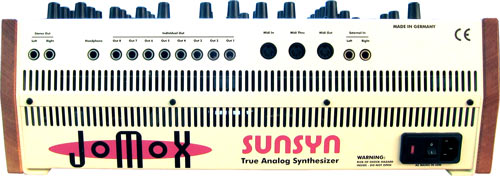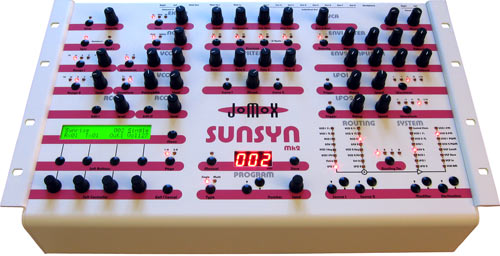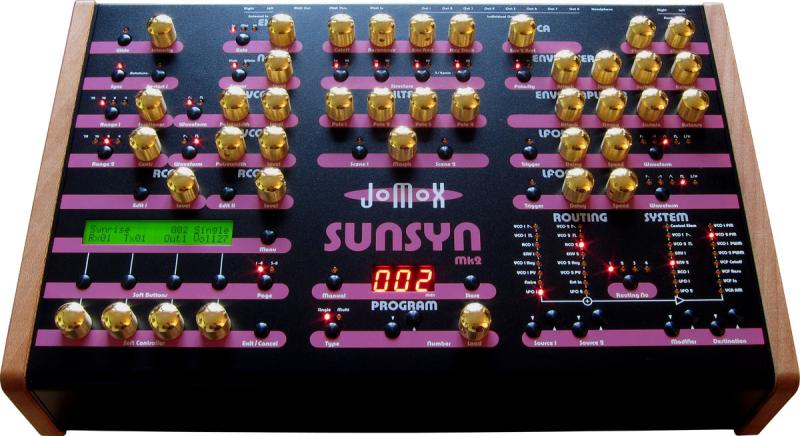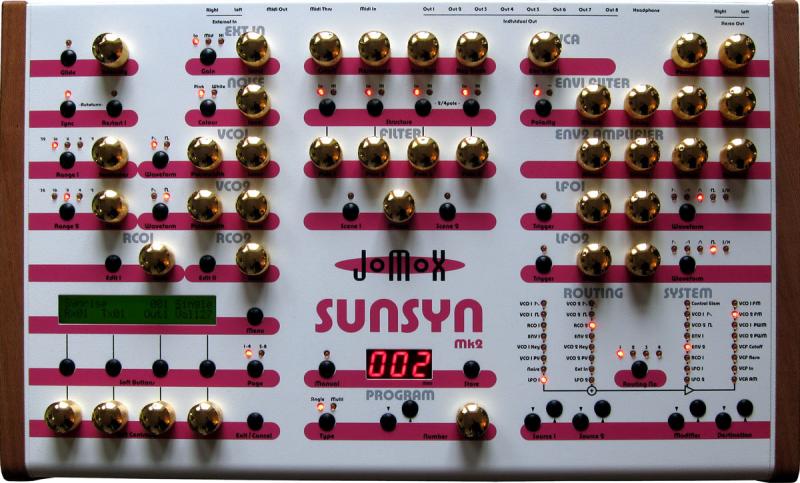Filter on ALL, SYNTH, DRUM, SAMPLER or MISC |
Total list currently 2405 items in 330 Brands |
JoMoX | SunSyn mk2 |
Description | The creators of the JoMox SunSyn mk2 would rather describe it in their words as an "8-fold storable modular system" Not far off when you think of it's 8 voices as a monophonic complex synthesizer of its own. Analog is most powerful if it is storable and you can control it by midi with a computer. Otherwise you start again from scratch each time you have a wonderful sounding preset... Oscillator Section Every SunSyn voice has two true analog oscillators, built up in discrete circuit technology and featuring the classic waveforms saw, square and pulse with pulse width modulation. Besides that, every voice has two so called RCOs (Ramp Controlled Oscillator). It's the first time digital waveforms can be mixed with true analog VCOs. Therefore digital waveforms become alive like never before and open up new dimensions of sound aesthetics. That makes a total of 4 oscillators per voice. The RCOs are organized in 7 wave sets with 252 waveforms each that are stored in the internal flash memory. These can be uploaded with a free SunSyn Wave Editor tool by midi dump. The RCOs are also capable to play back short samples and to digitally FM modulate themselves or serve as a modulation source in the analog routing matrix. Filter Section The filter section contains a fully configurable 4 pole true analog filter. On each pole, high/lowpass characteristics and coefficients (i.e. the basic cutoff frequency for each pole) can be adjusted individually. So you have the possibility to crossfade continuously from a typical Moog 4pole to an 18db - 303 lowpass to an Oberheim-like 2pole filter. Additionally, using the HP/LP switching for each pole, it is possible to create the most spacy bandpass- and highpass-filter sounds. Furthermore, you can store all filter-parameters in 2 scenes and MORPH (in the analog domain!) between them. Envelopes According to the machines conception, both envelopes are discreet analog circuits and super fast. One can be inverted. Typical envelope modulation paths are hard wired and have their own knob on the front panel. LFO's There are two LFOs per voice. Each one can be delayed or applied to events. Waveforms are triangle, saw up/down, square and random. The rate is adjustable between approx. 1kHz and 0,02Hz to create super slow sweeps. Modulation One of the most exiting innovations of the SunSyn is the routing system. It turns the SunSyn into an 8-voice modular synth with programmable routing system. And it is absolutely easy to use. In addition to the fixed routings (e.g. Env1->VCA) you have 4 flexible and programmable routing paths per voice, called Routing Element. You can picture routing elements as a modular system's cable, with two inputs (sources) and one output (destination). They are connected by an electronically controlled knob (modifier) to control the intensity. The intensity itself can be modulated by any Midi-Controller (e.g. controller, velocity, aftertouch) or by an analog audio-signal from the SunSyn. So you create 'modulated modulations'. Besides that, the signals of each voice can modulate among each other. Up to now, this was only possible with 'real' (and huge) modular systems. Everything works of course in the analog domain. Therefore no operation is limited by fixed point calculation errors (as in DSPs), but instead offers full dynamic-range for chaotic effects which apear on many modulations. Every modulation path is easy edited and understandable by one single view on the front panel. A an example both VCOs are cross-modulated. This needs 2 Routing Elements, one for each voice. The intensity of the modulation can be controlled by e.g. key velocity. But this is just for starters. At the same time, an external audio signal is mixed with noise and cutted into pieces by LFO1 and is mixed into the filter input. Now there still remains one Routing Element to e.g. ringmodulate RCO 1 and RCO2, and let the result modulate the VCA amount (if RCO2 is the source and RCO1 the modifier, both signals get multiplied; the result is a ring modulation). The final sound result should be spaced out in every sense of the word. Control Panel There is a knob or lighted button on the control panel for every important function. All in all, there are 40 of them. |
| Brand | JoMoX |
| Model | SunSyn mk2 |
| Device | Synth |
| Type | Desktop/Rack |
| Engine Type | Hybrid |
| Engine | VCO, WT |
| LFO | 2 Sample & Hold, Saw Up, Saw Down, Square, Triangle |
| Engine Detailed | 2 VCOs per voice; waveforms: saw, square, pulsewidth. 2 RCOs per voice (digital waveforms that follow the analog oscillators) |
| Filter (VCF) | 1 12dB Slope (2-pole), 18dB Slope, 24dB Slope (4-pole), Band Pass, High Pass, Low Pass, Notch, Resonance |
| Envelope (VCA) | 2 ADSR |
| Memory | 256 Single / 128 Multi / 7 wavesets |
| Arpeggiator | Up-Down |
| Keys | 0 |
| Key type | N/A |
| Velocity | N/A |
| Aftertouch | N/A |
| Audio | Stereo out + 8 individual outs and a stereo input. |
| Midi | I-O-T |
| CV-gate | Audio in can be CV in |
| Produced: | 2010 - 2010 |
| Legend: | Obvious | Y: Yes, N: No, N/A: Not Applicable | |
| VCO | Voltage Controlled Oscillator | DCO | Digital Controlled Oscillator |
| LFO | Low Frequency Oscillator | Sub | Sub Oscillator |
| VCF | Voltage Controlled Filter | VCA | Voltage Controlled Amplifier |
| Velocity | As with a piano, the harder you hit a key, the louder the sound, unlike most organs which always produce the same loudness no matter how hard you hit a key. | Aftertouch | Pressing a key after you activated it. Channel Aftertouch, no matter which key, it will send a Channel message. Poly Aftertouch, sends the pressure per key instead of the whole channel. |
| Values for OSC, LFO, Filter, Envelope are per voice unless stated otherwise. | |||






